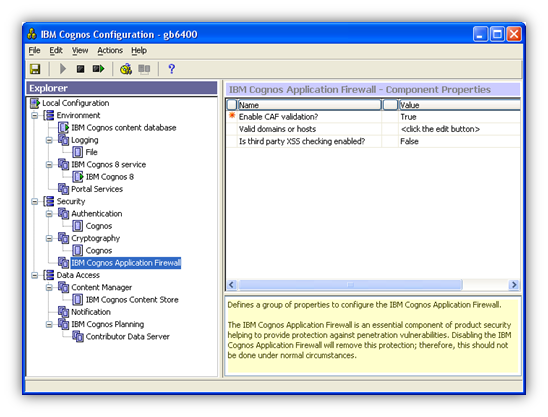IBM Cognos 8 Mashup Service (CMS), a new web service shipped with the 8.4 Platform, is an API (application programming interface) that automatically and securely exposes BI content as a web service for use in operational applications, business process management (BPM) workflows and mashups. With this capability, you now can extend your BI content into existing applications and processes that are critical to your business users as well as add new context by “mashing” content with other applications. Read more
If you’ve spent any time administering or configuring an IBM Cognos installation, then you have likely encountered and possibly pondered the feature known as the Cognos Application Firewall (CAF). The name itself seems to attract attention, and we are often asked for additional information about this feature by administrators and information security professionals who work closely with the IBM Cognos platform at their organizations.

Read more
One of the advantages that IBM Cognos 8 brings to the table in any implementation is the ability to handle varying data sources. One particularly complex data source that is often encountered is SAP BW. IBM Cognos has invested heavily in this integration, giving SAP customers the potential to significantly enhance the value they get from information stored in their BW instances.
Prior to IBM, Cognos had long touted it’s strategic relationship with SAP. Practically speaking,the alignment that existed could have been improved upon, as optimizing two very strong yet complex tools is challenging. IBM’s recent involvement and influence in the Cognos/BW product direction, armed with their long standing relationship with SAP has been positive. As consultants and implementors, we have seen significant transparency and progress toward a much better, more integrated solution, allowing Cognos/BW customers to leverage more of the Cognos 8 BI capability.
One of the most challenging aspects of establishing any enterprise business intelligence platform is the design and implementation of a security model that is flexible and extensible enough to meet the needs of your business while also remaining simple enough to administer and maintain. Every organization is unique in how they operate, so a structure that best suits one may not necessarily be appropriate for another. Because of these fundamental differences, there is unfortunately, no single archetype for business intelligence security. There are however a few proven guidelines which if followed, will help to ensure that whichever solution you arrive at will work in harmony with your IBM Cognos 8 environment. Read more
Page Breaking is a useful feature to offer report consumers. However, it’s often difficult to do this if the item you want to break on is dynamic. Here we show you how to do this with cascading, optional prompts while page breaking on the lowest level chosen.
Just about two years ago, before Cognos was acquired by IBM, Cognos did some acquiring of its own. Cognos purchased Applix and its flagship product, TM1. With the subsequent news regarding Cognos’ acquisition, TM1 and its integration into the Cognos suite of products became a minor press release. That’s about to change. Read more
One of the issues with using text box prompts is the possibility of receiving incorrect, misspelled, or non-existent entries. This allows the report to run and return unexpected data. Recognizing this, a user would have to return to the prompt page to re-enter values into the text box prompt. Wouldn’t it be nice if there was a way to automatically validate entries against some specified rules while remaining on the prompt page? Read more

